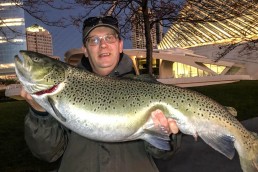Monster Brown Trout
SHARE THIS POST
The White River, Arkansas. Tierra del Fuego, Argentina. The inland waters of New Zealand. There are only a few places in the world where an angler has a shot at some of the biggest brown trout on the planet.
The one I left off the list above is the one right in our backyard, Lake Michigan! Yes, we are definitely on the list of the best places on earth to catch a 20-, 25-, 30- or even 40-pound brown trout. Our state has hung a 40-pounder on the board and the lake itself has at least two in that category. Forty pounders put us into an elite group that even Argentina must tap out of.
Because it is in our backyard, do we take it for granted? I, for one, do not. Since I started this fishing 40+ years ago, the brown trout has always been my favorite fish. As they get bigger and bigger, they get more and more wise, elusive, loaners. Hunting giant browns is very similar to chasing muskies. Everything has to be right. You need to be in the right place at the right time and hope they make a mistake! Remember, they don’t get to 20 pounds by making a lot of mistakes. As much fun as it is to land a 15- or 18-pounder and release it back to the lake unharmed, I always think, “darn I just made that fish a little more wary and tougher to catch.” But release is the only option to get a chance to grow a true super tanker.
It’s April right now and we find ourselves in one of the three best periods to tangle with a giant brown. I’ll go through these periods of the season and the best tactics to get yourself into a 30-pound-class giant.
Ice-out
The term ice-out is relative year to year. Some seasons, it can be in late February and some seasons it can be in late March. It can even be early April around the northern counties of Wisconsin. In the southern counties like Kenosha, Racine and Milwaukee, we generally have a full ice-out around March 1. In Sturgeon Bay, or further up into Door County, it can be more like early April.
Ice can come and go in the “ice-out” period, but I consider it a full ice-out when the ice leaves not only the lake proper and the main harbors, but also the harbored areas like the marinas. It’s also when the water starts a gradual warming. The best years are when the ice goes out and stays off. The worst springs are when it continually clears and then re-freezes. It puts the fish in a limbo and you never have the spring you hope for those years. There is nothing you can do, it’s all about weather patterns.
The areas I am waiting to open at ice-out are the deep boat harbors. These fish have staged in here all winter. When the lid comes off and feeding begins, it’s a great time to have one make a mistake. The big fish will come high to feed but will rarely be found in the shallows. They will want to be close to deep water. Smaller fish can be found shallow in spring, but I rarely see giants in the shallows in spring.
A morning and evening pursuit
Despite the cold water, the best chance at connecting is still first light and last light. These fish are very smart and will likely spot an imposter in broad daylight. Grey skies, wind and waves will also help the angler’s odds.
You have heard me say it before; tubes are my #1 bait for big Browns. A 3.5-inch smooth pearl white tube with an internal head weighing 3/8-ounce is always on my jigging rod in spring. There is something non-threatening, and an easy target about a tube. Over the years, I’ve caught more giants on tubes than any other lure—especially in spring. Work it deep, slow and steady within 3 to 4 feet of the bottom on 8-pound co-polymer or fluorocarbon line. No braid. Clear line only.
Are you enjoying this post?
You can be among the first to get the latest info on where to go, what to use and how to use it!
Batting second is going to be a 1/2-ounce blade bait in pearl white or gold. This too has special big-fish appeal, especially in cold water. Like the tube, this bait should be worked deep near the bottom.
A third bait that has giant brown appeal is a deep minnow bait. The Deep Thunderstick and the Bandit Deep Walleye are two proven favorites. Neither of these baits is great for casting into the wind, so conditions have to be right. Wind at your back in order to get a long enough cast to get it deep. You can go with a little heaver line for crankbaits, so a 10-pound co-polymer is good.
Summer blitz
After about May 1, the giants seem to disappear and-in general-shore and near-shore fishing can be slow through mid May and June. Around the first week of July, the lake stratifies and the presence of a west wind will pull all kinds of fish in, including giant browns. The attraction is the spawning alewives that are thick in the harbors at this time.
The first line of offence is the live alewife. Use the biggest ones you can catch. They swim and struggle more and don’t tire out as fast. Fish them on a slip-sinker rig with a 1 or 1.5-ounce egg sinker. Circle hooks are a must for clean releases. Fishing early mornings, evenings or even night fishing is a must during this period.
While the live baits are soaking, don’t forget to work a tube or blade bait near the bottom in the same areas. Breakwalls and deep harbor areas are the places to focus on during summer. If you have access to areas 18 feet or deeper with schools of bait, you will be in business.
The browns will be at their heaviest during this period.
Fall post spawn
Brown trout spawning will take place from late August through late October and early November. By late October, some of these browns complete their spawning and start to put on the feedbag. This feeding binge puts them in a vulnerable position and another chance for a real giant to make a mistake. They can be found deep, but this is the one time of the season that they will be shallow and hanging around the areas where they just completed spawning. There is no way to just focus on giants during this period. It’s just a numbers game and you hope you can run across a super tanker. Put away the tubes and blade baits now. This is minnow-bait season. Big minnow baits like #14 Husky Jerks. These fish like a big, easy meal and a big minnow-bait ripped and looking injured is irresistible.
Unfortunately, you will encounter some real tankers in the late fall, but they will weigh the least that they do all season. Whether male or female, they are spawned out and thin and starting their recovery. During this period, I have had several 40-inch Browns that barely weigh 20 pounds. They can be huge specimens with giant, grotesque jaws, but light for their length.
Wisconsin’s Lake Michigan is one of a handful of places in the world where you can tangle with a trout in the 20- to 40-pound class. Don’t take it for granted. We are sitting on a world-class fishery. No need to travel to New Zealand or Argentina. Keep this trophy fishing world-class. Consider releasing browns. They don’t die after 4 years like salmon. They will continue to grow and grow. In our state, politics have clouded science and stocking numbers of browns (whom are thriving in the current state of the lake) are being decreased for more salmon stocking. Every brown is important, so let them grow if possible.
MWO
SHARE THIS POST
Did you enjoy this post?
You can be among the first to get the latest info on where to go, what to use and how to use it!
Marc Wisniewski
Marc Wisniewski is an avid Wisconsin angler specializing in Lake Michigan shore and inshore fishing. He also chases bass, pike, and muskies anywhere he can. He has built custom rods for 35 years and makes lures from wood, lead and soft plastics. Wisniewski has been writing fishing articles for more than 30 years.



